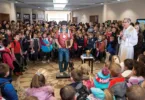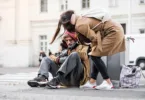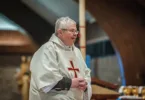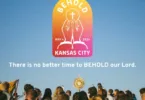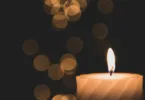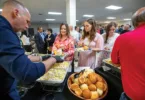
by Tom Hoopes
Special to The Leaven
ATCHISON — Many Catholics are familiar with the Blue Mass, which honors law enforcement; the Red Mass, offered for lawyers and judges; and the White Mass, which recognizes health care professionals.
But what is a Gold Mass?
The first regional Gold Mass for scientists was held Nov. 16 at Benedictine College in Atchison and celebrated by Msgr. Stuart Swetland, president of Donnelly College in Kansas City, Kansas. He is both a physicist and a Rhodes Scholar, and the event lived up to its billing: St. Benedict’s Abbey Church was filled for the event.
“The turnout was excellent, and the students were very interested,” he said.
“Both/And” was the theme of Msgr. Swetland’s homily — he stressed the need to study both science and faith.
“You can know much about the artist by studying his art,” he said. “In God’s case, you can know much about God by studying his creation. Everyone should have some degree of scientific study.”

The Gold Mass takes its color from the gold hoods that denote a science doctoral graduate, and the Mass is the brainchild of the Society of Catholic Scientists. There are more than a dozen such Masses nationwide, held on or near the feast day of St. Albert the Great, who has been called “the last man to know all there was to know.” He wrote on philosophy, theology, botany, geography, astronomy, zoology, music and physiology, and is the patron saint of scientists and philosophers.
The society is an international organization that has grown rapidly since its 2016 founding — there are already 1,600 members in over 50 countries. It hopes to be a resource to the church while building fellowship among scientists, witnessing to the harmony between faith and science, and exploring the intersection of faith and science. The regional chapter of the society is led by Benedictine College professors Christopher Shingledecker, an astronomer, and Matthew Ramage, a theologian, along with KU physics and astronomy professor Michael Murray.
Msgr. Swetland said the archdiocese is an ideal place for the society.
“We have the best facilities going, and we see that across the archdiocese in the medical fields, our research facilities and educational institutions,” he said. “Often, those who are most likely to believe are those who are involved in the hard sciences.”
Gold Masses are typically followed by a short lecture to stimulate discussion at a reception where Catholic scientists and those interested in a dialogue of faith and science can engage one another and grow in fellowship.
The regional Gold Mass was followed by a brief talk by Ramage called “Faith, Science and the University,” a take-off on Pope Benedict XVI’s famous 2006 Regensburg Address, officially titled “Faith, Reason and the University.”
In his remarks, Ramage quoted St. John Paul II: “Faith and reason are like two wings on which the human spirit rises to the contemplation of truth” and said the phrase sums up the work of the society. That phrase is noted in the entryway of Westerman Hall, the recently renovated and expanded science building on Benedictine College’s campus.
“The main takeaway can be captured by the words of St. John Paul II: ‘Be not afraid,’” said Ramage. “The church need not fear scientific discoveries, for nature — as the medieval saw it — was God’s ‘other book.’”
He noted that while the church doesn’t ask Catholics to adopt any scientific conclusion, the two “books” have much to tell each other.

Shingledecker, who was recently recognized for internationally significant astronomical work, said that events like the Gold Mass and the reception afterwards are important to address a key error of the 21st century.
“There is a false scientific utopianism, which seeks to extrapolate the rapid advances of science in the 20th century infinitely far into the future, and expects science is the answer to everything,” he said.
“I think that [there is] a growing awareness,” he continued, “that science depends on things such as ethics that are completely — and by definition — beyond its capability to fruitfully inform.”
Ramage saw the same positive trend.
“The future relationship between science and faith looks very bright indeed. When I began working in this area over a decade ago, only infrequently did I encounter other Catholic academics who were dedicated to this dialogue,” he said. “Nowadays, the situation is vastly different.”
He recommended books by Christopher Baglow, Stacy Transancos and others.

Paul Burghart is evidence of the new awareness of the harmony between faith and science. The 2015 graduate of Benedictine College, who attended Mass on campus for the feast of St. Albert, said that learning the proper relationship between faith and science made a huge difference in his life.
Growing up in McPherson, he said, “I always had the impression that science and the Catholic faith were in tension. Both were presented as true, but they were also seen as irreconcilable. . . . I loved my science classes and I loved my faith, but as I progressed through high school, I had an ever-growing sense that someday I would have to choose between them.”
A course in college changed everything for him.
“Truth cannot contradict truth,” his professor said. “Both faith and reason have been given to mankind by God as ways to pursue and find out the truth. . . . When a tension arises between the two, we don’t simply choose one or try to accept a contradiction. Rather, we patiently and diligently work to reconcile the difficulty, coming to a fuller understanding of the truth.”
“This simple presentation of the Catholic Church’s view of the matter completely shifted my view of the relationship between faith and the sciences,” Burghart said, and he spent the rest of his college career at Benedictine studying the intersection of faith and science, including reading deeply into Galileo’s writings.
Msgr. Swetland had the same experience as a student — only starting from science, not theology.
“I was a physics major and I lost faith during one phase of my life,” he said. “There was one thing I could not deny, though. The more I studied the physical world, the subatomic world and the heavens — I couldn’t deny the Creator.”
“Science helped salvage faith for me,” he added. “The Society of Catholic Scientists want more and more people to be able to say that.”

